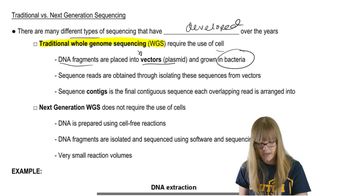Table of contents
- 1. Introduction to Genetics51m
- 2. Mendel's Laws of Inheritance3h 37m
- 3. Extensions to Mendelian Inheritance2h 41m
- 4. Genetic Mapping and Linkage2h 28m
- 5. Genetics of Bacteria and Viruses1h 21m
- 6. Chromosomal Variation1h 48m
- 7. DNA and Chromosome Structure56m
- 8. DNA Replication1h 10m
- 9. Mitosis and Meiosis1h 34m
- 10. Transcription1h 0m
- 11. Translation58m
- 12. Gene Regulation in Prokaryotes1h 19m
- 13. Gene Regulation in Eukaryotes44m
- 14. Genetic Control of Development44m
- 15. Genomes and Genomics1h 50m
- 16. Transposable Elements47m
- 17. Mutation, Repair, and Recombination1h 6m
- 18. Molecular Genetic Tools19m
- 19. Cancer Genetics29m
- 20. Quantitative Genetics1h 26m
- 21. Population Genetics50m
- 22. Evolutionary Genetics29m
15. Genomes and Genomics
Sequencing the Genome
Problem 8
Textbook Question
You have just obtained 100 kb of genomic sequence from an as-yet-unsequenced mammalian genome. What are three methods you might use to identify potential genes in the 100 kb? What are the advantages and limitations of each method?
 Verified step by step guidance
Verified step by step guidance1
Step 1: Use computational gene prediction algorithms such as ab initio methods. These algorithms analyze the DNA sequence to predict gene locations based on known gene structures, such as open reading frames (ORFs), start and stop codons, and splice sites.
Step 2: Employ comparative genomics by aligning the 100 kb sequence with sequences from well-annotated genomes of closely related species. This method identifies conserved regions that are likely to be genes.
Step 3: Utilize transcriptome data, if available, by mapping RNA-Seq reads to the 100 kb sequence. This approach helps identify expressed genes by detecting exons and splice junctions.
Step 4: Discuss the advantages of each method: Ab initio methods are useful for novel genomes without prior data, comparative genomics leverages evolutionary conservation, and transcriptome data provides direct evidence of gene expression.
Step 5: Consider the limitations: Ab initio methods may produce false positives, comparative genomics requires closely related reference genomes, and transcriptome data may miss genes not expressed in the sampled tissues or conditions.
Recommended similar problem, with video answer:
 Verified Solution
Verified SolutionThis video solution was recommended by our tutors as helpful for the problem above
Video duration:
1mPlay a video:
Was this helpful?
Key Concepts
Here are the essential concepts you must grasp in order to answer the question correctly.
Gene Prediction Algorithms
Gene prediction algorithms are computational tools used to identify potential genes within a genomic sequence. These algorithms analyze sequence features such as open reading frames (ORFs), splice sites, and promoter regions to predict gene locations. While they can provide quick insights, their accuracy can vary based on the quality of the input data and the specific algorithm used.
Recommended video:
Guided course

Mapping Genes
Comparative Genomics
Comparative genomics involves comparing the genomic sequence of the unsequenced mammalian genome with those of well-characterized genomes. By identifying conserved sequences across species, researchers can infer the presence of genes and their functions. This method is powerful but relies on the availability of closely related genomes for effective comparisons.
Recommended video:
Guided course

Genomics Overview
Transcriptome Analysis
Transcriptome analysis, often performed through RNA sequencing, examines the complete set of RNA transcripts produced in a cell or tissue. By analyzing the transcriptome, researchers can identify expressed genes and their variants. However, this method requires prior knowledge of the tissue or developmental stage being studied and may miss non-coding genes or those expressed at low levels.
Recommended video:
Guided course

Chi Square Analysis

 8:55m
8:55mWatch next
Master Sequencing Overview with a bite sized video explanation from Kylia Goodner
Start learning




